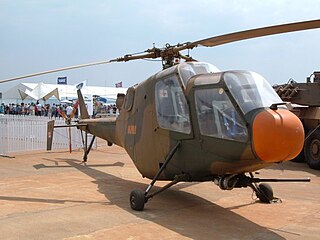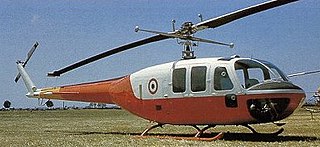
The Atlas XH-1 Alpha is a prototype attack helicopter built by Atlas Aviation of South Africa, which used it as a concept demonstrator for the then-planned Rooivalk project.

The AérospatialeSA 321 Super Frelon is a three-engined heavy transport helicopter produced by aerospace manufacturer Sud Aviation of France. It held the distinction of being the most powerful helicopter to be built in Europe at one point, as well as being the world's fastest helicopter.

The Kamov Ka-60 Kasatka (Russian: "Касатка", is a Russian medium twin-turbine military transport helicopter under development by Kamov. It performed its first flight on 24 December 1998.

The Aerotécnica AC-12Pepo is a Spanish two-seat light helicopter manufactured in 1956 by Aerotécnica.

The Aerotécnica AC-14 was a Spanish five-seat light helicopter of the 1950s, designed by Jean Cantinieau, based on enlarging his Nord Norelfe design.

The Agusta A.115 was a prototype helicopter flown in 1961 in Italy. It was essentially a Bell 47J-3 with an unclad, tubular tail boom, and powered by a Turbomeca Astazou II turboshaft engine. No production ensued.

The Agusta A.101 was a large prototype transport helicopter developed in Italy during the 1960s. Despite prospective orders from the Italian armed forces, no buyers emerged and the project was abandoned in 1971.

The Agusta A.103 was an Italian prototype single-seat light helicopter flown in October 1959. The pilot was enclosed by a perspex bubble with the engine at the rear and the tail rotor carried on an enclosed boom.

The Agusta A.104 Helicar was an Italian prototype light commercial helicopter first flown in December 1960.

The Agusta A.106 was a single-seat light helicopter designed to provide an anti-submarine warfare (ASW) platform for the Impavido-class destroyers of the Italian Navy. The aircraft was provided with a sophisticated electronics suite by Ferranti for autostabilisation and contact identification. Two torpedoes could be slung under the fuselage. The tail and two-bladed main rotor could be folded for shipboard stowage, and the skid undercarriage had fittings for flotation bags.

The Agusta AB.102 was an Italian helicopter produced in small numbers in the early 1960s. The aircraft was based on the mechanical components of a Bell 48 that Agusta incorporated into an all-new, streamlined fuselage. The first flight was on 3 February 1959 and the prototype was exhibited at that year's Paris Air Show in faux military colours. Only two production examples were built, operated by Elivie in a regular air service between Turin and Milan from 1961. However, the advent of turbine-powered helicopters in the 1960s soon rendered the AB.102 obsolete.

The Agusta AZ.8L, or Agusta-Zappata AZ.8L, was an Italian airliner prototype first flown on 9 June 1958. It was of conventional low-wing monoplane configuration with tricycle undercarriage and all-metal construction. Filippo Zappata's design grew out of a twin-engined transport designated AZ.1 that was never built.

The Sikorsky XH-39, developed by Sikorsky Aircraft in 1954, was the U.S. Army's first turbine-powered helicopter. It was fast and innovative, but ultimately rejected by the United States Army in favor of the Bell UH-1 Iroquois.

The Kawasaki KH-4 was a light utility helicopter produced in Japan in the 1960s as a development of the Bell 47 that Kawasaki had been building under licence since 1952. The most visible difference between the KH-4 and its forerunner was its new and enlarged cabin. This was fully enclosed and provided seating for three passengers side-by-side on a bench seat behind the pilot's seat. The helicopter was provided with a new control system, revised instrumentation, and larger fuel tank.

The Kellett XR-10 was a military transport helicopter developed in the United States in the 1940s that only flew in prototype form. It was designed in response to a USAAF Technical Instruction issued for the development of a helicopter to transport passengers, cargo, or wounded personnel within an enclosed fuselage. Kellett's proposal followed the general layout that the company was developing in the XR-8, with twin intermeshing rotors, and was accepted by the Air Force on 16 October over proposals by Sikorsky, Bell, and Platt-LePage.
The SNCASE SE.3200 Frelon (Hornet) is a French helicopter built in the late 1950s. Intended to serve as a multirole helicopter for the French Army, Air Forces and Navy, two prototypes were built and flown before the project was dropped in favour of the SA 3210 Super Frelon.
The Meridionali/Agusta EMA 124 was a light utility helicopter flown in prototype form in Italy in 1970. The design was undertaken by Agusta for production in a joint venture with Elicotteri Meridionali, based on the Bell 47 that Agusta was building under licence at the time.
The Nord 1750 Norelfe was a 1950s French three-seat helicopter built by Nord Aviation and designed by Jean Cantinieau.
The Airmaster H2-B1 is a British two-seat ultralight helicopter built by Airmaster Helicopters of Camberley, Surrey.

The Airbus Helicopters H160 is a medium utility helicopter being developed by Airbus Helicopters. Formally launched at Heli-Expo in Orlando, Florida on 3 March 2015, it is intended to replace the AS365 and EC155 models in the firm's lineup. In June 2015, the first test flight took place. It received its EASA type certification in July 2020, and first deliveries were in December 2021.

















